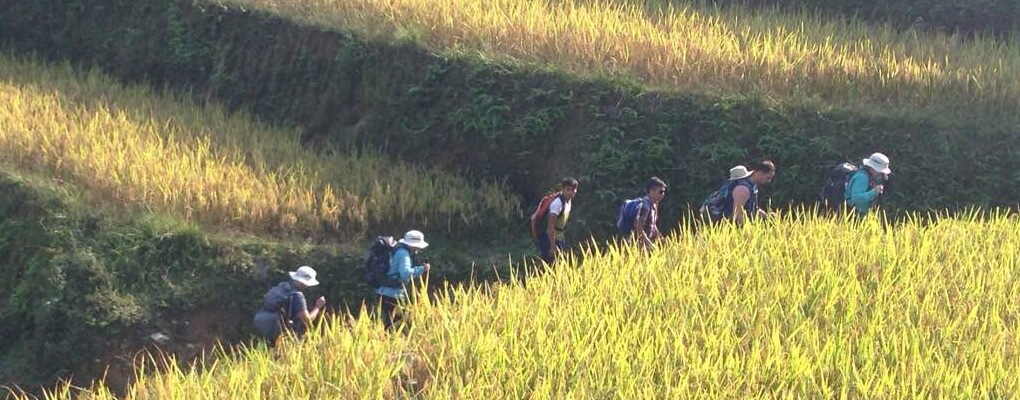Vietnam
As Vietnam is a long, narrow country from north to south climate conditions vary considerably. The climate can be divided into three distinct patterns between the north, central and south regions. The climate in the north is generally humid and subtropical, although the winter months from November to March can be colder with temperatures from 10 – 15 degrees. Summer months, May to September can be quite hot with temperatures from 30 – 35 degrees. Meanwhile south Vietnam enjoys a tropical climate all year round, with little variation throughout the year (around 27 – 32 degrees), however May to November is the rainy season when short, heavy downpours are quite frequent. Central Vietnam lies somewhere in between. The coastal strip is usually dry and hotter from April to October while November to March is wetter and cooler. A light rain jacket and small umbrella are recommended year round.
-
Easy
Suitable for most people in good health, these easy walks are predominantly on good paths, at low altitude and on undemanding terrain. Previous walking or trekking experience is not necessary.
-
Easy to Moderate
This grade is ideal if you want to enjoy both easy and moderate level walks on the same tour. You’ll be walking mainly on good paths and at low altitude, with occasional more demanding ascents or descents.
-
Moderate
For those who are fit and active, these moderate walks are normally on good paths and tracks at low altitude. Days may include some fairly demanding ascents and descents, so previous experience is preferable but not essential.
-
Moderate to Challenging
Combining moderate grade walks with some more strenuous hikes. This grade is ideal if you are fit and want to challenge yourself with a few longer, more demanding trekking days, possibly on difficult terrain or at higher altitudes.
Equipment
Mai Chau- Pu Luong: You will be provided sleeping mat, mattress, pillow, mosquito net and blanket. No sleeping bag provided.
In Sapa mountain villages , HaGiang area, Bac Ha villages : You will be provided sleeping bag, mattress, pillow, mosquito net, blanket & toilet kit (shampoo, toothbrush, towel). All of gears need to request before departure
Bedding on overnight trains You will be provided with clean sheets and a blanket for the overnight train journeys.
Water Bottle Water along the trail must never be considered as drinkable. Take a 1.5 litre personal water bottle (preferably insulated). Our support crew on the trek provide sterilized water each meal time to replenish your supplies. Also energy snacks (nuts, cereal bars etc.) are recommended whilst on trek.
Walking Poles These may be useful for the uphill / downhill sections of the Sapa, Bac Ha, Ha Giang and north Vietnam mountain trek. Adequate poles can also be bought in Sapa.
Sunglasses A good pair of sunglasses are essential for protection against UV rays.
Sun Hat, High Factor Sun Cream/Block & Lip Salve Bring suncream (Factor 15 or more) to protect your skin against the sun. A combination sunblock/ lipsalve is ideal for facial protection.
Torch/Batteries/Bulb A small torch is essential for finding things at night etc. Often a head torch is useful around the villages at night. Remember to bring some spare batteries.
Toiletries Try to keep heavy cosmetics etc to a minimum. Essentials are toothbrush/paste, soap, small towel, small nail brush. Wet wipes are great for a quick clean up, so bring a pack of those.
Footwear
Clothing
Luggage: On Tour
Luggage whilst on trek:
This should consist of a main piece of baggage, a holdall or kitbag for the trek, and a daypack to carry your personal gear. We recommend you have a holdall or kitbag for the overnight trek in Sapa, purely for ease of access to your things and to save on space. Your overnight bag will be taken to the village nightstop by vehicle.
Day pack
On each trekking day you will only be required to carry your day pack or light rucksack, large enough to carry essential items such as water, snacks and sun/weather protection.
Luggage storage in Hanoi
For a small charge you can use one of hotel bases in Hanoi or Sapa to leave the bulk of your gear while away on treks in Mai Chau or remote Sapa, Ha Giang villages. Consult your tour leader for further information on storage. You will require a lockable additional bag for this purpose.
